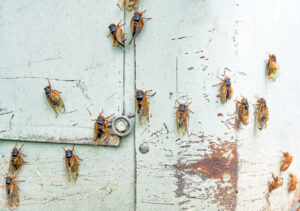Brood X refers to the billions (yes, billions) of cicadas which recently emerged from their 17 year underground slumber. Cicadas are serenading residents and their pets throughout 18 states in the mid-Atlantic region including Tennessee. In fact, Tennessee is one of five states considered an epicenter for cicadas. The others include the states of Maryland, Northern Virginia, Indiana as well as Washington D.C.
Cicadas have no personal boundaries. They fly around with abandon. Dogs who like to chase bugs will especially enjoy cicadas which are large and fly anywhere and everywhere. Most dogs do not have discerning palates and enjoy eating all types of things they find while enjoying time outside. Because of the ridiculous amount of cicadas available, your dog may think she has stumbled upon an all-you-can-eat dog buffet. Though cicadas are non-toxic, dogs who ravenously consume them may experience stomach problems.
“In most cases, your dog will be fine after eating a few cicadas,” says Dr. Jerry Klein, AKC chief veterinary officer. The key word here is few. Dogs that gorge themselves on the large, crunchy insects could experience severe stomach upset. The exoskeleton of cicadas is difficult for dogs to digest. Digesting too many cicadas may result in your dog having abdominal pain, vomiting, and bloody diarrhea. If your dog experiences any of these symptoms or is uncommonly lethargic, contact your veterinarian. Your dog may require intravenous fluids, pain medication or other medication, including anti-nausea drugs.
The cicada cycle will last about six weeks ending approximately at the end of June. However, those tasty exoskeletons left behind after cicadas shed will remain for a longer period. Vigilance will be necessary until they are gone. Prevention is key. Stopping your dog from feasting on cicadas is safest. Accompany your dog anytime he goes outside the next couple of months. Though it may be an inconvenience, doing so will protect your dog from the after effects of munching on one too many cicadas.


